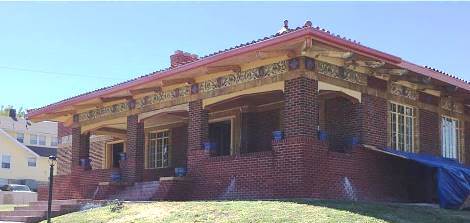The former Simmons Funeral Home at 37th and Strong Avenue, Kansas City, Kan., has been turned into apartments.
The Simmons Senior Villas project held its ribbon-cutting earlier this month, and the historic building in Argentine has been adapted into seven apartments.
The renovation of the historic Simmons building is just half of the project that was developed by the Argentine Neighborhood Development Association, in partnership with Newmark Grubb and Zimmer, according to Ann Murguia, ANDA executive director.
The second part of the project is the renovation of the former El Centro building at 1333 S. 27th St. That building also has a historic background as a railroad layover dormitory in former times, built in 1930.
Argentine residents wanted to save the old Simmons building, but there were not a lot of uses that it could find for the historic building, so the Simmons building was converted into a seven-unit apartment complex, Murguia said.
The $5.5 million renovation project will be housing for those 55 and older, she said.
Some of the final touches are being put on the building currently, and it is expected to be ready for tenants after Dec. 1, she said. There is no lack of interest from prospective tenants.
“We have had over 25 people on a list for several months now,” Murguia said. “The interest has been overwhelming.”
The recent ribbon-cutting was done in 1920s-style, she said, with 1920s music, hors d’oeuvres and champagne.
Murguia described the price range of the apartments as “affordable.”
The old El Centro building includes a huge lobby area that is “breathtakingly beautiful,” Murguia said. Visitors during the open house earlier this month remarked about its appearance, she added. There will be a kitchen or dining area in some of the larger space there.
She said she hopes to use the community space there for a variety of purposes, including programs for people 55 and older.
Simmons is a smaller building, and it will have a mini-community space, she added.
Murguia remarked that the top property owner in Argentine currently is the Housing Authority. As Argentine has grown and prospered, adding developments, there is a greater demand for higher-end housing and better quality housing, she said. ANDA is trying to cater to that market and raise the standard of living in the Argentine area, she added. The Simmons building is in the Sixth Commission District.
It was nice to be able to take two attractive historic buildings and preserve them, especially when there is not a lot of attractive historic property that is well preserved in Argentine, she said.
Those who toured the old Simmons building were mostly interested in security, and Murguia said each apartment would have its own security system.
The Simmons building was not always a funeral home. It was built in 1921 as a 20-room hospital for Dr. David E. Clopper, according to its National Register of Historic Places application. The building was placed on the National Register in 2014. Besides being a surgeon for the Atchison, Topeka and Santa Fe Railroad railroad, Clopper also served as Argentine mayor and a bank president.
When Dr. Clopper died in 1935, George Simmons and his son Gib bought the building and used it as a mortuary. The Simmons family continued to operate the funeral home until 2007.
Fred S. Wilson, a local architect, designed the Simmons building in the Mission and Craftsman styles. The building is noted for its terra cotta ornamentation and clay tile roof, as well as iron ornamentation.
Wilson’s other local projects included the H.W. Gates funeral home building in Rosedale, Brown Road Methodist Episcopal Church in the Argentine area and an apartment building on the northeast corner of 25th and Minnesota Avenue, according to the historic site application.
In 1921, when the Simmons building was constructed, its cost was $350,000, Murguia said, a huge amount of money in those days.
“We pulled up carpeting and tiles in the hallway and were able to refinish the 1921 wood floor and to preserve it,” she said.
The wood floor was made out of fir, and was able to accept some water damage through the years and recover. Had it been oak, it might have been destroyed by past flooding and roof leaks, she added.
Currently, some historic photographs from the Simmons family that detail the history of Argentine are on temporary display at the Simmons building, she added.
Like several other historic property projects that have been done in the past few years in Kansas City, Kan., this project received historic tax credits from the state of Kansas, as well as federal historic tax credits, Murguia said. The affordable tax credits allow the rent to be lower, while it is still a step above Section 8 types of projects, she added.


